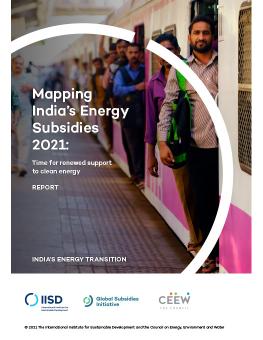
Mapping India's Energy Subsidies 2021: Time for renewed support to clean energy
This report examines how the Government of India has used subsidies to support the various energy sectors in India since announcing its renewable energy target of 175 GW by 2022, a goal that has now been increased to 450 GW by 2030. It also projects shifts in energy subsidies due to COVID-19. Two special segments look at how subsidies can best promote solar manufacturing in India and how India's public sector undertakings can support the clean energy transition.
-
In FY 2020, subsidies to renewable #energy in #India fell nearly 45% from their 2017 peak.
-
Fossil fuels continue to receive far more subsidies than clean #energy in #India. This disparity became even more pronounced from FY 2019 to FY 2020, going from 7 times to 7.3 times the size of subsidies to renewables.
-
In FY 2020, seven major Indian energy public sector undertakings spent USD 3.1 billion on fossil fuel projects—11 times as much as they invested in renewable #energy projects.
Tracking the shift of government resources to fund clean energy instead of fossil fuels is important to ensure public money supports India’s goals for energy access, affordability, energy security, and sustainability. Mapping India's Energy Subsidies 2021 covers India’s subsidies to fossil fuels, electricity transmission and distribution, renewable energy, and electric vehicles between fiscal year (FY) 2014 and FY 2020.
We found that fossil fuels continue to receive far more subsidies than clean energy in India. This disparity became even more pronounced from FY 2019 to FY 2020, going from 7 times to 7.3 times the size of subsidies to renewables.
Key figures:
- Subsidies to electricity transmission and distribution make up the largest bucket at around INR 1.3 lakh crore (USD 18.2 billion) in FY 2020. While this amount stagnated between FY 2019 and FY 2020, it is likely to grow again as the economy recovers.
- Oil and gas subsidies increased by 16% from FY 2019 to FY 2020, reaching INR 55,347 crore (USD 7.8 billion).
- Subsidies to renewable energy fell nearly 45% from their peak in FY 2017, stagnating at around INR 8,000 crore in FY 2020.
- Electric vehicle subsidies have more than doubled since FY 2019, reaching INR 1,141 crore (USD 161 million) in FY 2020.
- In FY 2020, seven major Indian energy public sector undertakings (equivalent to state-owned enterprises) spent INR 22,261 crore (USD 3.1 billion) on fossil fuel projects—11 times as much as they invested in renewable energy projects.
- Total capital expenditure of energy public sector undertakings in India stood at INR 1.5 lakh crore (USD 22.4 billion) in FY 2020 and is expected to increase in the near term.
We also looked at how the government could support its “Make in India” initiative, asking what kind of policy support the domestic solar manufacturing industry needs. We found that:
- Domestic manufacturers require demand-side certainty to trigger expansion and integration.
- States must develop healthy manufacturing ecosystems.
- To improve competitiveness, the government needs to target fiscal incentives together with research and development.
The report is accompanied by an interactive online database to help browse the subsidy data in detail and includes detailed spreadsheets and annexes for policy-makers and researchers. The analysis is the latest update in the India's Energy Transition series from the International Institute for Sustainable Development's (IISD) Global Subsidies Initiative (GSI) and the Council on Energy, Environment and Water (CEEW). For previous iterations of this study, see:
You might also be interested in
Mapping India's Energy Subsidies 2020: Fossil fuels, renewables and electric vehicles
How have India’s energy subsidy policies changed? What have been the most significant developments in India’s dynamic energy policy environment? And is public support aligned with India’s desired energy future?
Unpacking India’s Electricity Subsidies: Reporting, transparency, and efficacy
This report brings together data on the state of electricity subsidies in India, covering all states and union territories.
How to Target LPG Subsidies in India: Step 2. Evaluating policy options in Jharkhand
This report considers options for subsidy targeting in India by using a survey of over 900 households to analyze the distribution of LPG subsidies in the state of Jharkhand.
Part 1 – How Can India’s Energy Sector Recover Sustainably from COVID-19?
From IISD and CEEW, Part 1 of a three-part commentary series takes a deep dive into how India’s energy sector is coping with the impacts of COVID-19 and what this means for the sustainable energy transition.